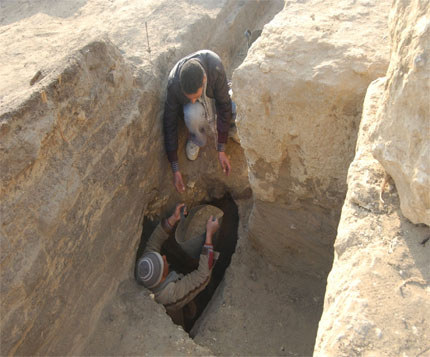Posted by Hanan Mahmoud
Working in excavations requires you to be patient and record everything stratigraphically starting from modern to old. But working in trenches enables you to answer specific questions. Sometimes archaeologists have to make “shofi holes”.
An interesting thing happened to me with my team members during our excavation in Trench G in Menkaure Valley Temple at Giza 2012. We were working behind one of the limestone core blocks that dates to Menkaure; suddenly we heard a loud yelp. It was one of our workers crying when he fell down into an unseen hole our excavations had uncovered. The depth of this hole was about 3 meters and 0.41 meters in diameter. Luckily, our worker was not hurt. The archeologists use the hole to read the stratigraphy and the limestone foundation of the temple as a shofi hole. This pit revealed to us the courses of lime stone core block.
Moreover, the most famous discoveries in ancient Egyptian history happened in this way. For example, Carter found the tomb of the king Montohotep “neb hebt re” in Deir El Baharei in Luxor. A horse fell down the shaft of the tomb. Also Zahai Hawas discovered both of the workmen cemetery at Giza and the Golden mummies in Baharia Oasis when a donkey fell down and sunk in the sand.
My colleague Rabee Eissa mentioned to me that during his work at Keranies, he was resting after feeling tired. Suddenly, a worker disappeared because he fell down one of the underground access points to expose the floor of a granary that dates to Greco-Roman time. This access point was a hatch a covered wooden door in a bedroom of a house.
Also, my colleague Mohamed Elkhateeb was working at Abydos when one of his workers fell down a hole exposing a Greco Roman tomb.
Bad things can sometimes be useful.


